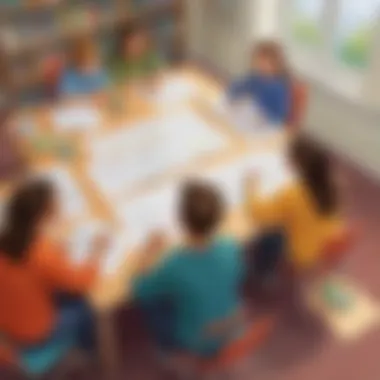How to Start a Class: Essential Steps for Educators


Intro
Initiating a class marks a critical juncture in the educational process. It is more than just a logistical activity; it sets the tone for the entire learning experience. Every educator, whether seasoned or new, must navigate various steps to create an effective learning environment. Understanding the essential elements can significantly influence students' engagement, motivation, and learning outcomes. This guide aims to distill these elements into actionable insights that educators can easily implement.
In this comprehensive guide, you will explore classroom management strategies, engagement techniques, and interactive materials. It also sheds light on how to align curricular objectives with students' interests and needs, providing a structured approach to the initiation of a class.
Interactive Learning Games
The use of interactive learning games is an effective strategy for educators seeking to engage students actively. Game-based learning fosters an environment where children can explore concepts at a pace that suits them. Moreover, these games facilitate collaboration, problem-solving, and critical thinking among learners.
Popular Games
Several popular educational games hold significant potential for classroom engagement. These include:
- Kahoot!: An interactive quiz platform that makes reviewing material fun.
- Prodigy: A math-based game that adapts to students' skill levels, ensuring a personalized experience.
- Minecraft: Education Edition: This game encourages creativity while teaching subjects like math, history, and science.
Description of top educational games
These games not only make learning entertaining but also allow for diverse educational approaches. Kahoot! uses quizzes to reinforce concepts, while Prodigy adapts math challenges based on individual competency. Minecraft: Education Edition promotes teamwork and planning through project-based learning.
Benefits of playing educational games for kids' cognitive development
Research shows that educational games can enhance cognitive abilities, such as memory and problem-solving skills. They allow students to practice real-world skills in a controlled environment, fostering both independence and collaboration.
Game Reviews
Below are reviews of selected educational games that highlight their effectiveness in the learning process.
- Kahoot!: Widely recognized for its ease of use, this game captures students' attention through competitive quizzes. It is particularly useful for reinforcing knowledge with instant feedback.
- Prodigy: This game provides a rich, personalized experience that encourages students to solve math problems in a fantasy setting. Teachers often note improved performance in math skills among those who engage regularly with Prodigy.
- Minecraft: Education Edition: A powerful tool for subjects like history and science, this game encourages creativity and teamwork. The building aspect supports learning through visual representation and imaginative narratives.
Comparison of gameplay and learning outcomes
When comparing gameplay experiences and educational outcomes, it is clear that games like Prodigy yield measurable improvements in math scores, while Kahoot! enhances retention through engaging revision sessions. Minecraft offers a unique blend of creativity and collaboration that has profound impacts on group learning dynamics.
Educational Topics
Education encompasses a wide range of subjects, from math to languages and sciences. An interdisciplinary approach enriches the learning experience.
Compilation of articles covering various subjects
Compiled articles can serve as a resource for teachers looking to diversify their teaching material. They cover essential topics such as:
- Math strategies for problem-solving
- Interactive language practice
- Experiments that illustrate scientific principles
Importance of interdisciplinary learning for holistic development
Interdisciplinary learning plays a crucial role in fostering connections among subjects, promoting deeper understanding. It prepares students for the complexities of real-world situations where knowledge from various fields often intersects.
Tips and Tricks
Educators and parents can significantly enhance the educational journey through practical strategies.
Practical tips for parents and educators
- Encourage curiosity by asking open-ended questions.
- Allow for ample hands-on experiences that cater to various learning styles.
- Create an environment rich in positive reinforcement to motivate students.
Strategies for making learning fun and engaging
Utilizing enthusiasm and creativity keeps learning interesting. Incorporating educational games, collaborative projects, and real-world connections leads to higher engagement levels among students.
Creative DIY Projects
Engaging students in hands-on activities nurtures creativity and cognitive skills.
Step-by-Step Guides
Constructing simple DIY projects can inspire creativity and problem-solving abilities. These projects include:
- Building simple models for science lessons.
- Creating art projects that explore themes from literature or history.


Craft Ideas
Utilizing simple household items can lead to innovative craft ideas. For example:
- Tissue paper flowers to explore color mixing.
- Paper mâché projects to understand structural design.
Collectively, these ideas underline the importance of artistic expression in children's development, offering pathways to enhance critical thinking and creativity. The integration of such activities into classroom settings can create a vibrant and engaging atmosphere where all students can thrive.
Understanding the Educational Context
Understanding the educational context is essential for any educator embarking on the journey of starting a class. This foundation sets the stage for effective teaching and learning. By grasping the nuances of the environment in which they operate, educators can make informed decisions that enhance student engagement and achievement.
In essence, an educational context encompasses various factors, including the institutional framework, cultural backgrounds of students, and specific learning objectives. Recognizing these elements allows teachers to tailor their approach to fit not only the curriculum but also the diverse needs of their learners. This understanding directly impacts how lessons are formulated and delivered.
It is vital for educators to contextualize their teaching strategies to optimize learning experiences for all students.
Defining Class Objectives
Defining clear and measurable class objectives is crucial for guiding both teaching and learning. Objectives provide focus and direction. They inform students about what they should achieve by the end of the lesson. When educators establish these goals, they create a roadmap that can lead to successful outcomes.
Furthermore, well-articulated objectives help educators assess their effectiveness. By confronting their teaching with these benchmarks, they can determine areas that require adaptation or enhancement. Objectives should align with educational standards and be relevant to students’ interests, making learning more applicable and motivating.
Identifying Student Needs
Identifying student needs is an indispensable part of crafting an effective learning environment. Each student comes with a unique set of experiences, strengths, weaknesses, and learning styles. Recognizing these factors enables an educator to develop a more personalized approach.
Attention to student needs can involve various strategies, such as conducting surveys or informal assessments prior to class initiation. Creating an inclusive atmosphere requires understanding disparities in knowledge, emotional readiness, and cultural contexts.
Additionally, this process contributes to building trust, allowing students to feel seen and respected. By understanding their classroom's diversity, teachers can better facilitate a supportive and engaging atmosphere that promotes academic and personal growth.
Curriculum Preparation
Curriculum preparation serves as a cornerstone in establishing an effective class. It involves thoughtful planning and aligning educational goals with the standards set by educational authorities. In this foundation of teaching, educators must consider the needs and capabilities of their students alongside the requirements of the curriculum. Proper preparation enables teachers to create a cohesive learning experience, ensuring that every student engages meaningfully with the content.
Aligning with Standards
Aligning curriculum with educational standards is crucial. Standards outline what students should learn at each grade level. They provide a framework that teachers can follow, ensuring that the necessary knowledge and skills are taught consistently. When educators align their curriculum with these standards, they enhance the validity of their instructional practices. It helps in assessing student performance accurately and aids schools in maintaining accountability.
Moreover, standards-based teaching enables teachers to set measurable goals. These goals can be used to track student progress and make necessary adjustments throughout the academic year. Goals should not just focus on knowledge retention but also on the application of learned concepts in real-world situations. For instance, a robust understanding of math standards might involve problem-solving scenarios that students can face outside the classroom.
Aligning with standards enhances educational consistency and accountability, providing a clear roadmap for student success.
Selecting Appropriate Materials
The choice of materials significantly impacts student engagement and learning outcomes. Selecting appropriate educational materials involves understanding both curricular goals and student interests. Materials can range from textbooks and workbooks to multimedia resources and hands-on activities. Selecting diverse resources helps address different learning styles among students, fostering a more inclusive environment.
When evaluating materials, educators should consider:
- Relevance: Ensure that the content is relevant to the curriculum objectives and student interest.
- Accessibility: Consider the accessibility of materials for all students, including those with learning difficulties.
- Variety: Offering different types of media can make learning more dynamic. This could involve videos, articles, and interactive software.
Selecting the right materials also contributes to cultivating a rich learning atmosphere. For example, using interactive simulations can increase student interest in scientific concepts or historical events, thereby enhancing the overall learning experience.
Developing a Detailed Lesson Plan
A detailed lesson plan acts as a roadmap for each class session. It delineates the objectives, instructional strategies, and assessment methods that will be employed to guide student learning. Crafting an effective lesson plan is more than merely outlining the day's content. It involves anticipating potential challenges and planning alternative strategies to meet diverse student needs.
An effective lesson plan generally includes:
- Objectives: Clear, specific objectives that define what students should achieve by the end of the lesson.
- Instructional Steps: Step-by-step sequences that explain how to present the content, including methods of delivery such as lectures or group work.
- Assessment: Strategies to assess understanding, ensuring that students grasp the lessons taught.
- Reflection: Space for teachers to reflect on the success of the lesson and student engagement may be included for future improvement.
Logistical Considerations
Logistical considerations play a crucial role in setting the foundation for effective teaching and learning. A well-thought-out classroom environment not only enhances student engagement but also creates a positive atmosphere that is conducive to learning. Teachers must prioritize space arrangement, resource allocation, and visual aids while considering the diverse needs of their students. These elements are essential for improving the overall classroom experience.
Setting Up the Classroom Environment
Creating an appropriate classroom environment is the first step to establishing a productive learning space. The physical arrangement of desks, chairs, and materials directly influences student interaction and focus. To optimize the setting, the following factors should be assessed:
- Space Utilization: The layout should facilitate movement and interaction among students. Desks can be arranged in clusters for group work or in rows for traditional lectures.
- Accessibility: Ensure that all resources are within reach. It promotes independence and gives students the autonomy to gather materials as needed.
- Comfort and Safety: Comfortable seating and safety features should be prioritized. A comfortable environment alleviates distractions, allowing students to concentrate better.
In addition, consider adding elements that make the space welcoming, such as decorations that reinforce the learning material. Visual aids like posters can serve as reminders of key concepts and enhance the overall educational atmosphere.


Organizing Resources and Materials
Effective organization of resources and materials streamlines activities and minimizes disruptions during class. A clutter-free environment can lead to improved focus and efficiency. Key considerations include:
- Categorization: Sort materials by subject or activity type. Having a clear system reduces time spent searching for necessary items and enables smooth transitions between lessons.
- Storage Solutions: Use storage bins, labeled folders, and shelves to keep resources tidy. These solutions not only save space but also instill a sense of responsibility among students regarding their learning materials.
- Technology Integration: If using technology, ensure easy access to devices like tablets or computers. Set up charging stations and designate areas for tech-related activities.
By maintaining an orderly classroom, students can focus more on learning rather than managing distractions caused by disorganization.
A well-organized classroom is ready for learning, reducing stress for both teacher and students.
Each of these logistical considerations contributes to the overall effectiveness of the teaching process, directly impacting student success and classroom dynamics.
Establishing Classroom Management
Establishing classroom management is vital for creating a productive learning environment. Effective classroom management provides structure and stability, enabling students to focus on their studies without unnecessary distractions. Educators must implement strategies that promote discipline, respect, and engagement among students. When managed well, both the teacher and the students benefit, leading to improved academic performance and a positive classroom atmosphere.
Creating Classroom Rules and Expectations
Classroom rules and expectations form the framework for acceptable behavior. Establishing clear rules from the start is essential. Rules should be few, simple, and directly related to key behaviors you want to encourage. For example, rules like "Raise your hand to speak" can foster respect and order in discussions.
- Clarity: Students must understand what is expected of them. Articulating rules in a straightforward manner helps avoid confusion.
- Involvement: Engaging students in the process of creating these rules promotes ownership and reinforces adherence. Consider asking students for their input during discussions.
- Consistency: Enforcing these rules consistently is crucial. Inconsistency can lead to misunderstandings and may undermine your authority.
Establishing clear rules sets the tone for the entire classroom environment.
Developing Routines and Procedures
Routines and procedures streamline classroom activities and enhance learning experiences. Having established routines fosters a sense of security and predictability, allowing students to transition smoothly between different parts of the class. Here are some key areas to address:
- Daily Start: Begin each class with a routine that signals when learning begins. This might be a bell, an announcement, or a brief warm-up activity.
- Handling Transitions: Clear instructions on how to move from one task to another minimize chaos. For instance, using a timer for group activities can help manage time efficiently.
- End-of-Class Procedures: Outline what students should do when class is ending, such as returning supplies or preparing to leave the room. Consistent end-of-class routines can help wrap up lessons methodically.
Utilizing Positive Reinforcement
Positive reinforcement is an effective strategy to encourage desired behaviors in the classroom. By acknowledging good behavior, teachers foster an environment where students feel appreciated and motivated to succeed. Methods for positive reinforcement include:
- Praise: Recognize individual and group achievements verbally. Simple statements like "Great job on that project!" can boost morale.
- Rewards: Offer small incentives, like stickers or extra recess time, for meeting behavior expectations. These rewards can create excitement around positive behavior.
- Classroom Celebrations: Plan periodic celebrations for the entire class when group goals are achieved. This not only reinforces positive behavior but also builds community.
Establishing effective classroom management sets the groundwork for a successful educational experience. By creating clear rules, developing routines, and utilizing positive reinforcement, educators can cultivate a conducive learning environment that benefits all students.
Engagement Strategies
Engagement strategies are essential components of initiating a class effectively. These strategies focus on capturing and maintaining student interest throughout the learning process. When students are actively engaged, they are more likely to absorb information, participate, and develop a deeper understanding of the material. Tailoring engagement methods to varying learning styles and needs can make a significant difference in classroom dynamics.
Incorporating Interactive Learning Activities
Interactive learning activities are vital for elevating the educational experience. These activities can range from hands-on projects to technology-based tasks that encourage collaboration and creativity. For instance, using tools such as Kahoot! for quizzes or interactive whiteboards can stimulate discussion and excitement. Additionally, group projects allow students to work together, fostering teamwork and communication skills. Activities should be designed to be inclusive, ensuring all students can participate and benefit.
Benefits of incorporating interactive activities include:
- Enhanced retention of information through practical application.
- Greater motivation, as students often respond positively to active participation.
- Development of social skills, enabling students to engage with their peers.
Facilitating Group Discussions
Group discussions serve as a powerful engagement tool in the classroom. Facilitating these discussions allows students to voice their thoughts and perspectives on subjects. It encourages critical dialogue within the class, helping students learn from one another. By creating an environment where students feel safe and respected, educators can unlock diverse viewpoints and richer conversations.
Some ways to facilitate effective group discussions are:
- Establish clear guidelines about respect and active listening.
- Promote open-ended questions to inspire deeper thought.
- Encourage every student to contribute, even if it’s just a comment.
Group discussions can enhance students' ability to articulate their thoughts and engage in constructive criticism. This is essential not only for academic development but also for social growth.
Encouraging Critical Thinking
Critical thinking is a skill fundamental to education and life beyond. Encouraging students to question assumptions and explore various solutions to problems nurtures analytical capabilities. Strategies may include case studies, debates, and scenario-based questions that require thoughtful responses.
Benefits of fostering critical thinking include:
- Improved problem-solving skills, enabling students to tackle complex issues.
- Heightened creativity as students explore multiple solutions.
- Increased preparedness for future academic and professional challenges.
Educators can use various techniques to promote critical thinking, such as:
- Socratic questioning, prompting students to defend their reasoning.
- Group brainstorming sessions, allowing collective idea generation.
- Analytical writing assignments, where students evaluate and reflect on concepts.*


Engagement strategies are not just tactics; they are essential for creating a vibrant learning environment where students thrive.
By integrating these elements, educators lay a solid foundation for effective teaching practices. These strategies promote deeper understanding and fulfillment in the educational journey.
Assessing Student Progress
Assessing student progress is critical for educators striving to create an effective learning environment. It allows teachers to understand how well their students grasp the material and plan future lessons accordingly. Through assessments, educators can pinpoint the strengths and weaknesses of each student’s learning journey. These insights enable targeted instruction and support.
Implementing Formative Assessments
Formative assessments refer to the ongoing evaluations that happen during the learning process. These assessments help teachers gauge students’ understanding and proficiency. Using a variety of formative assessment methods, such as quizzes, class discussions, or interactive polls, allows for real-time feedback. This feedback can be particularly useful to strengthen areas where students struggle.
Benefits include:
- Immediate Feedback: Educators can adjust lessons on-the-fly, tailoring instruction to meet student needs.
- Enhanced Engagement: Students often respond better when they know their understanding is regularly checked.
- Informed Planning: Teachers can easily identify common misconceptions and address them promptly.
Formative assessments encourage a more dynamic and responsive teaching approach. Tools such as Kahoot! or Google Forms can make these assessments engaging for students while also providing useful data for teachers.
Utilizing Summative Assessments
Summative assessments serve a different purpose. These are typically conducted at the end of a unit or course to evaluate what students have learned. They provide a comprehensive overview of student mastery and are often used to assign grades.
Types of summative assessments include:
- Final Exams: Comprehensive exams covering all material from a term.
- Projects: In-depth assignments that require students to demonstrate their knowledge creatively.
- Standardized Tests: Common assessments that compare performance across different populations.
Summative assessments can be beneficial for:
- Evaluating Overall Progress: They help educators understand the efficacy of their teaching methods over a significant period.
- Setting Future Goals: Results can guide curriculum development and instruction for future classes.
- Accountability: They provide data that can be shared with stakeholders, including parents and administrators.
Both formative and summative assessments are essential for a holistic view of student learning. They ensure that teaching approaches are effective and that each student is supported in their educational journey. As noted by experts in education, a balanced approach can provide the best insights into student progress.
Feedback and Reflection
Feedback and reflection form an integral part of the educational process. This phase allows educators to assess both teaching effectiveness and student understanding. Effective feedback can illuminate areas of strength and highlight opportunities for growth. In addition, reflection on teaching practices supports continuous improvement. This relationship between feedback and reflection enhances the learning environment, fostering an atmosphere conducive to academic success.
Gathering Student Feedback
Collecting feedback from students is a critical practice for teachers. It helps understand student perceptions regarding the course material, teaching methods, and classroom dynamics. Several methods can facilitate this process:
- Surveys: Anonymous surveys can encourage candid responses. They give insight into which strategies resonate and which may require adjustment.
- Exit Tickets: These quick reflections at the end of a class can provide immediate feedback on student understanding or engagement with the lesson.
- Group Discussions: Facilitating open forums where students can voice their thoughts promotes dialogue and helps identify collective challenges.
These approaches ensure students feel heard. This not only aids in instructional adjustments but also enhances their involvement in the learning process.
Reflecting on Teaching Practices
An equally important aspect of feedback involves educators reflecting on their methods. This reflection could take various forms:
- Self-Assessment: Regularly evaluating one’s teaching strategies against outcomes helps identify gaps and strengths.
- Peer Observations: Inviting a colleague to observe a class can provide an external perspective on teaching effectiveness.
- Professional Development: Engaging in workshops focused on innovative teaching methods can inspire fresh ideas and improve practices.
Teachers must dedicate time for this reflection. It is imperative to translate feedback into actionable insights. In summary, both gathering feedback from students and reflecting on teaching methods are essential. They create a cycle of improvement, ultimately leading to a more effective learning experience.
Adjusting Strategies as Needed
Adjusting strategies as needed is a crucial aspect of effective teaching. Engaging with students often requires dynamic shifts in instructional methods and classroom approaches. What works for one group may not suit another due to various factors such as age, learning style, and individual student needs. Therefore, being responsive and adaptable in teaching methods can lead to better learning outcomes.
Evaluating effectiveness should not be a one-time activity. Continuous assessment helps educators to observe what resonates with their students. Gathering data through assessments, feedback, and observation can illuminate areas needing improvement. Understanding these areas enables educators to enhance their teaching strategies actively.
Additionally, this process fosters a culture of resilience and continuous improvement among educators. By embracing change, teachers not only grow in their profession but also model critical thinking skills for their students.
"Effective teaching is not just about delivering content but about connecting with learners and responding to their needs."
Identifying Areas for Improvement
Identifying areas for improvement requires careful observation and insight. Teachers should routinely reflect on their lessons and outcomes. This may involve:
- Tracking student engagement during lessons and noting which activities hold attention.
- Analyzing assessment results to highlight content students struggled with.
- Collecting feedback from students on what aspects they found challenging or unclear.
Effective identification of improvement areas leads to targeted adjustments. For instance, if collaboration does not seem effective, a new group dynamic may be introduced. Alternatively, if students struggle with a particular type of content, additional resources might be integrated to provide support.
Implementing Changes Effectively
Implementing changes is as important as identifying them. It is essential that adjustments are carefully planned and executed to ensure they meet the needs of the classroom. Here are some strategies to implement changes effectively:
- Set clear goals for what changes aim to achieve. Ensure these goals are measurable and achievable.
- Communicate openly with students about changes. Let them know that their feedback is valued and that adjustments are being made to improve their learning experience.
- Monitor progress after implementing changes. This might involve ongoing assessments or informal check-ins with students. If new strategies are not yielding results, further refinement may be necessary.
- Be patient. Changes take time to manifest. Regularly reassessing strategies helps maintain momentum.
By adjusting strategies as needed, educators create an environment conducive to growth and learning.















